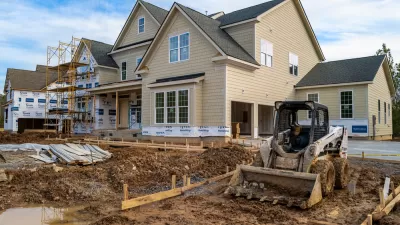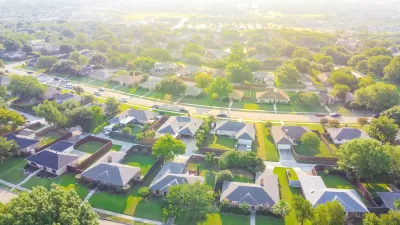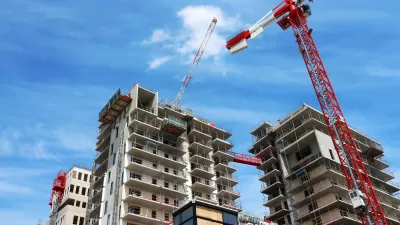Comparing different types of NIMBYism and where they go wrong.

Last week, I posted the following on X, formerly known as Twitter: “Both right-NIMBYism and left-NIMBYism are based on magical thinking: the idea that if you don’t build housing for a group of people (poor in Right version, not so poor in Left version) that group of people will magically disappear and stop troubling us.”* My post has gotten more likes than my typical Twitter post (which admittedly is not saying very much). Since this tweet got more interest than usual, I thought I would elaborate on the point.
One common argument against new market-rate housing (generally associated with the political Left) is that if it is not “affordable” (whatever that means) it will be “luxury” housing that is affordable to the most affluent renters or buyers. This claim is not always factually wrong**, but it is based on the assumption that new housing for the affluent does not benefit anyone else.
Why did I write that this theory is based on magical thinking? Because it assumes that if you don’t build new housing for affluent people, the residents of that new housing magically disappear, instead of competing with the non-affluent for housing.
But of course this is wrong: in the absence of new housing, affluent renters and buyers typically compete with other people for the existing housing supply, thus bidding up the price of housing. To put it another way, imagine the existing housing supply as an auction in which housing goes to the highest bidder: if affluent people who prefer new housing are removed from the auction, there are fewer bidders, which makes it likely that the highest bid will be lower than would otherwise be the case.
Thus, even insanely expensive buildings like New York’s new supertalls have some modest positive impact, and would probably have more positive impact if they were common. Why? Because people who buy new $10 million condos would be bidding for older condos if the new condos were not built, making the older condos even more expensive than they currently are.
One common claim, which seems to be based more on folklore than on evidence, is that the most expensive condos are never actually lived in, but used as investment vehicles. But this doesn't really matter for the purposes of my argument: investors can make a profit on old condos as easily as on new ones, so if the new condos don't get built, the investors would still be outbidding the rest of us for older housing.
Surprisingly, I got very little pushback to my tweet from the Left. I got much more pushback from right-NIMBYs who argued that exclusion works: if zoning excludes poor people from a neighborhood they may not disappear from the planet, but at least (unlike rich people) they do disappear from that neighborhood. For example, obviously zoning has been very successful at excluding people from rich suburbs. So these critics argued, in so many words: “What’s the problem? The poor people go to the poor neighborhoods where they belong.” So how can a non-NIMBY respond to that?
One possible response is that segregation is inherently a bad thing. But in a country where poor areas have sky-high levels of crime, and even not-so-poor diverse areas have higher crime rates than the most exclusionary suburbs, this argument is unlikely to persuade non-progressives.
A better response, I think, is that when zoning is extremely successful at limiting housing supply, that creates a variety of negative side effects. First of all, successful exclusion increases the demand for poor-neighborhood housing, which increases rents and housing prices in poor neighborhoods. People who could have bought a house in such areas in 1970 now must rent, and people who could have rented in 1970 now live in homeless shelters or the streets.*** In other words, zoning doesn’t just keep poor people out of rich neighborhoods: it even makes it impossible for some people to live in poor neighborhoods. And when zoning leads to homelessness, it negatively affects well-off areas, since homeless people can camp out on streets in those areas as easily as they can in poorer neighborhoods.
Street homelessness is not the only negative impact that high housing costs have on the nonpoor. Because zoning and other supply-limiting laws are so widespread, even people with six-figure incomes are excluded from large chunks of the American housing market, and the middle class is excluded from even larger chunks. And when people can’t live near the jobs they are best suited for, the economy as a whole suffers: in all but the highest-paying jobs, vacancies become harder and harder to fill.
Right-NIMBYs think of zoning as a set of arrows that inevitably hit the bull’s-eye target of “undesirable, crime-producing, drug-addicted poor people.” But in reality, zoning is like arrows shot by a drunk: they may be intended to hit the target, but instead go everywhere and hurt everyone.
*By “left-NIMBYism” I meant, in this context, opposition to new housing based on the desire to exclude higher-income people ( usually based on the claim that this will somehow help or protect lower-income people). By “right-NIMBYism” I meant opposition to new housing based on the desire to exclude lower-income people (usually based on the claim that this will protect moderate- and high-income people from the ill effects of being around lower-income people). And as most readers of this blog probably know, “NIMBY” is an acronym for “Not In My Back Yard.”
**Although it is a self-fulfilling prophecy: the less new housing a city allows, the more expensive that new housing will be.
***Some of the replies to my tweet suggested that because homeless people are often mentally ill or drug addicts, homelessness is not related to housing costs. But this is of course preposterous: society had plenty of alcoholism and drug addiction in the 1960s, but widespread homelessness is relatively new.

Alabama: Trump Terminates Settlements for Black Communities Harmed By Raw Sewage
Trump deemed the landmark civil rights agreement “illegal DEI and environmental justice policy.”

Planetizen Federal Action Tracker
A weekly monitor of how Trump’s orders and actions are impacting planners and planning in America.

How Atlanta Built 7,000 Housing Units in 3 Years
The city’s comprehensive, neighborhood-focused housing strategy focuses on identifying properties and land that can be repurposed for housing and encouraging development in underserved neighborhoods.

In Both Crashes and Crime, Public Transportation is Far Safer than Driving
Contrary to popular assumptions, public transportation has far lower crash and crime rates than automobile travel. For safer communities, improve and encourage transit travel.

Report: Zoning Reforms Should Complement Nashville’s Ambitious Transit Plan
Without reform, restrictive zoning codes will limit the impact of the city’s planned transit expansion and could exclude some of the residents who depend on transit the most.

Judge Orders Release of Frozen IRA, IIJA Funding
The decision is a victory for environmental groups who charged that freezing funds for critical infrastructure and disaster response programs caused “real and irreparable harm” to communities.
Urban Design for Planners 1: Software Tools
This six-course series explores essential urban design concepts using open source software and equips planners with the tools they need to participate fully in the urban design process.
Planning for Universal Design
Learn the tools for implementing Universal Design in planning regulations.
Jessamine County Fiscal Court
Caltrans
Institute for Housing and Urban Development Studies (IHS)
City of Grandview
Harvard GSD Executive Education
Toledo-Lucas County Plan Commissions
Salt Lake City
NYU Wagner Graduate School of Public Service






























